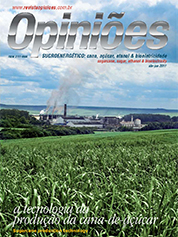José Guilherme Perticarrari
Technical Research Coordinator at CTC
Op-AA-28
A viable alternative
The mechanical planting of sugarcane is more than a trend in the sugarcane-based industry. It is one of the most viable alternatives to replace the manual planting system that currently faces difficulties, mainly due to the lack of labor in expansion areas and regions with high mechanical harvesting rates.
According to information supplied by the mills comprising the initiative “Controle Mútuo Agronômico Anual” of CTC (Sugarcane Technology Center), in the 10/11 harvest, approximately 217,000 hectares were planted in a mechanized manner, representing 35% of the total planted area.
Actually, mechanical planting is the direct consequence of the acceleration of mechanical harvesting that is growing exponentially in Brazil, and mainly in the State of São Paulo, where State Law nr. 11. 241 /02 sets forth the elimination of sugarcane burning by 2027, in all areas in which mechanized processing is possible, and by 2031 in all other areas, and where an Environmental Protocol was signed by sugar and ethanol producers, anticipating these dates to, respectively, 2014 and 2021.
High operational costs of manual planting and the intensification of compliance with the law are also factors accelerating the utilization of the mechanical planting system in lieu of the manual one. A recent survey conducted by CTC shows that in only three years mechanical planting might represent about 60 to 70% of the total sugarcane reformation area in the Center-Southern region, evidencing the accelerated migration to mechanical planting in comparison with the switch from manual to mechanical harvesting.
This migration process is taking place at higher speed than compared to the production sector’s capacity to develop high performance and reliable technologies for this planting system, putting at risk the long-term economic viability and sustainability.
In Brazil, the quest for this technology started to become expressive in the year 2000, but since the 90’s, CTC has strongly been engaged in this line of research, seeking to develop the system as a whole, i.e., understanding seed cane harvesting, transporting and planting operations.
Apart from developing planters, CTC was responsible for the first adaptation project of harvesters sold on a commercial scale and destined for seed cane harvesting, which resulted in an average reduction of 50% in damage to sugarcane billets during harvesting operations.
Currently, this concept is used by several device manufacturers to adapt harvesters, known as seed cane harvesting kits. At this time, this technology’s most important challenges lie in controlling planter operations, in the development of harvesters capable of harvesting seed cane, while balancing minimal damages with high operational performance, perfecting soil preparation practices for the sake of warranting good development and longevity of sugarcane plantations, at competitive cost and in a sustainable manner.
Experience obtained from the mechanization of planting shows that this practice requires a great deal of care and attention in comparison with manual planting. Aimed at achieving equal or better results than with the manual operation, apart from modifications made to machines, some techniques had to be developed, such as the method to assess variety aptitude for mechanical planting and the methodology to assess the quality of planting.
CTC stands out as a pioneer in elaborating and conducting field studies using these methodologies. Another important factor for the success of mechanical planting is the logistics system, because in comparison with the cutting, loading and transporting system, there is a far higher number of variables and it is a much more complex system.
Along this line, CTC developed a logic using a computer tool to simulate the mechanical planting system of sugarcane in a virtual environment, allowing to optimize resources and processes, reducing costs and assessing new investments and operational strategies.
Currently, the production sector relies on several sugarcane planter manufacturers, whereas the main novelties are with respect to controlling planting operations. In the market, another type of equipment, called Billet Distributor, is also available, which has the advantage that it uses the operational structure of the manual planting system, such as furrowers and coverers, and only distributes billets to the furrows.
This is an equipment that belongs in the mechanical planting system, but also needs improvement. Apart from billets harvested mechanically, with average lengths of 40 cm, there exists a commercial system being implemented, in which mini-billets, approximately 4 to 6 cm long and containing only one bud chemically treated so as to foster deeper roots, while reducing chances of attacks by pathogenic agents.
The novelty in not in the practice of planting mini billets, but rather, in how the product is made available for planting on a commercial scale. Finally, with a developed mechanical planting system, considerable planting cost reductions will occur, higher productivity and longevity will be attained in sugarcane plantations, along with better labor conditions in the field.
In addition to the development of this planting system, innovative and unconventional sugarcane distribution technologies on a commercial scale, encompassing scenarios of major cost reductions in agricultural production, the lack of labor, the possibility of year round planting, and sustainability are already being developed at CTC and expected to be available in 4 to 6 years.




